新目标八年级英语下册第二单元说课稿-Unit-2-I
2020年春人教新目标英语八年级下册Unit2全单元教案设计
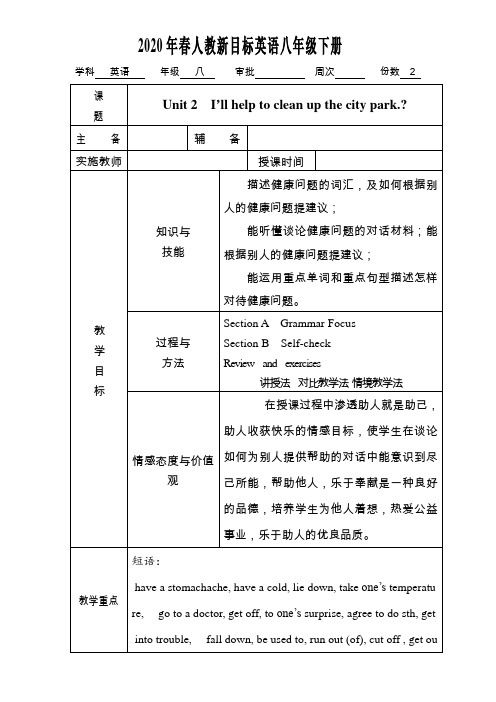
2020年春人教新目标英语八年级下册学科英语年级八审批周次份数 25 . 动词help及一些役使动词后面常省略to。
e.g. My mother wouldn’t let me go to the movie.妈妈不会让我去看电影的。
Step 5 Practice1. 4a: Fill in the blanks with the phrasal verbs in the box.1) Answers: put off; call up; come up with; cheerup; put up; hand out; give out2. 4b: Fill in the blanks with the correct forms of the verbs in the box.5) Check the answers with the Ss.3. 4c: Complete the sentences with your own ideas. Use infinitives.Tell Ss to read the sentences in 4a and try to fill in the blanks with the phrasal verbs in the box.让一名学生读每个句子的内容。
告诉学生们用自己的真实想法来完成句子。
作业Homework:1. Who will _______________ (自愿读) these words for us?2. The girl often _____ her mother ______ the dishes (帮妈妈洗餐具) on weekends.3. We ______her ________ (邀请来) to our party.4. The old man had ______________ (无事可做) every day.Answers: volunteer to read, helps / do, asked / to come, nothing to do板书设计1. sick adj. 生病的;有病的;辨析:sick 与ill2. raise v. 募集;征集e.g. They sold something to raise money.3. alone adj. adv. 独自;单独辨析:lonely 与alonelonely 情感上的孤独,寂寞。
新目标英语八年级下学期unit2全单元教案
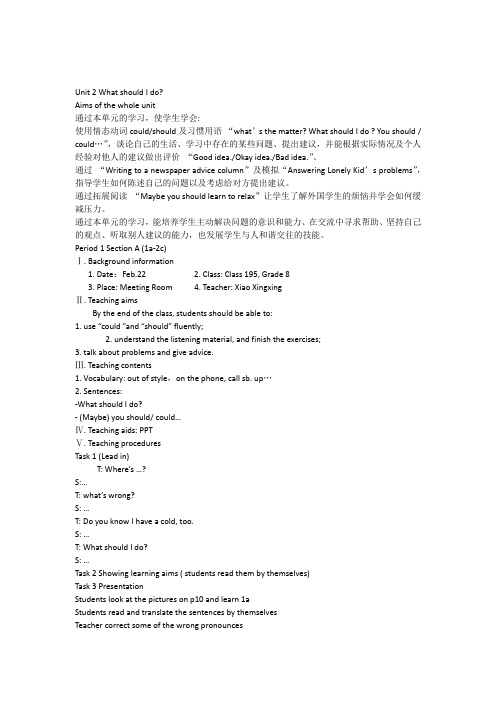
Unit 2 What should I do?Aims of the whole unit通过本单元的学习,使学生学会:使用情态动词could/should及习惯用语“what’s the matter? What should I do ? You should / could…”,谈论自己的生活、学习中存在的某些问题、提出建议,并能根据实际情况及个人经验对他人的建议做出评价“Good idea./Okay idea./Bad idea.”。
通过“Writing to a newspaper advice column”及模拟“Answering Lonely Kid’s problems”,指导学生如何陈述自己的问题以及考虑给对方提出建议。
通过拓展阅读“Maybe you should learn to relax”让学生了解外国学生的烦恼并学会如何缓减压力。
通过本单元的学习,能培养学生主动解决问题的意识和能力、在交流中寻求帮助、坚持自己的观点、听取别人建议的能力,也发展学生与人和谐交往的技能。
Period 1 Section A (1a-2c)Ⅰ. Background information1. Date:Feb.222. Class: Class 195, Grade 83. Place: Meeting Room4. Teacher: Xiao XingxingⅡ. Teaching aimsBy the end of the class, students should be able to:1. use “could ”and “should” fluently;2. understand the listening material, and finish the exercises;3. talk about problems and give advice.Ⅲ. Teaching contents1. Vocabulary: out of style,on the phone, call sb. up…2. Sentences:-What should I do?- (Maybe) you should/ could…Ⅳ. Teaching aids: PPTⅤ. Teaching proceduresTask 1 (Lead in)T: Where’s …?S:…T: what’s wrong?S: …T: Do you know I have a cold, too.S: …T: What should I do?S: …Task 2 Showing learning aims ( students read them by themselves)Task 3 PresentationStudents look at the pictures on p10 and learn 1aStudents read and translate the sentences by themselvesTeacher correct some of the wrong pronouncesStudents read the sentences togetherTask 4 Listening Ⅰa) Listen to the tape, and finish 1b.b) Check the answers.c) Students translate the phrasesd) read the sentences togetherTask 5 Listening Ⅱa) Read the advice and find students to translate them;Listen to the player, and finish 2a.Do 2b, and check the answers.Read after the player, and read it freely.When Peter has a problem, he will ask his friend for help. Then when you have a problem, will you ask your friend for help? Friends are important for us. So I will give you a proverb about friends: A friend in need is a friend indeed.患难见真情。
人教版英语八年级下册Unit2《I’llhelptocleanupthecitypark》说课稿
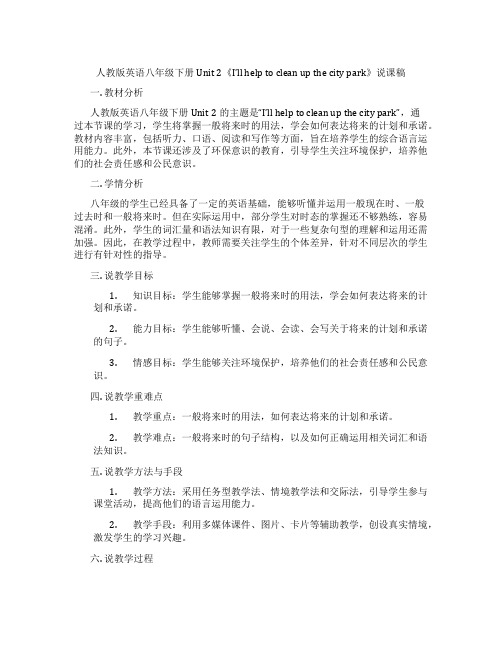
人教版英语八年级下册Unit 2《I’ll help to clean up the city park》说课稿一. 教材分析人教版英语八年级下册Unit 2的主题是“I’ll help to clean up the city park”,通过本节课的学习,学生将掌握一般将来时的用法,学会如何表达将来的计划和承诺。
教材内容丰富,包括听力、口语、阅读和写作等方面,旨在培养学生的综合语言运用能力。
此外,本节课还涉及了环保意识的教育,引导学生关注环境保护,培养他们的社会责任感和公民意识。
二. 学情分析八年级的学生已经具备了一定的英语基础,能够听懂并运用一般现在时、一般过去时和一般将来时。
但在实际运用中,部分学生对时态的掌握还不够熟练,容易混淆。
此外,学生的词汇量和语法知识有限,对于一些复杂句型的理解和运用还需加强。
因此,在教学过程中,教师需要关注学生的个体差异,针对不同层次的学生进行有针对性的指导。
三. 说教学目标1.知识目标:学生能够掌握一般将来时的用法,学会如何表达将来的计划和承诺。
2.能力目标:学生能够听懂、会说、会读、会写关于将来的计划和承诺的句子。
3.情感目标:学生能够关注环境保护,培养他们的社会责任感和公民意识。
四. 说教学重难点1.教学重点:一般将来时的用法,如何表达将来的计划和承诺。
2.教学难点:一般将来时的句子结构,以及如何正确运用相关词汇和语法知识。
五. 说教学方法与手段1.教学方法:采用任务型教学法、情境教学法和交际法,引导学生参与课堂活动,提高他们的语言运用能力。
2.教学手段:利用多媒体课件、图片、卡片等辅助教学,创设真实情境,激发学生的学习兴趣。
六. 说教学过程1.导入:通过展示城市公园的图片,引导学生谈论自己对公园的印象和感受,引出本节课的主题。
2.新课呈现:讲解一般将来时的用法,展示相关句子和例句,让学生感知和理解一般将来时的结构。
3.操练环节:通过听力练习、角色扮演、小组讨论等形式,让学生在实际语境中运用一般将来时。
新目标八年级英语下册第二单元说课课件

4. Use the body language and multimedia to make the lesson intuitive and interesting.
Emotion goals:Learn to think of themselves, and care for others through discussing problems together; develop the spirit of cooperation and the optimistic attitude of the students'.
Unit 2 • What should Ido? • SectionA(1a-2c)
Bai Jing Wantan No.1 Middle School
Part 1 Analysis of the teaching material • Part 2 Analysis of the teaching methods Part 3 Analysis of the students Part 4 Teaching process
Ability goals: Be able to talk about their own problems and troubles; find out the right solutions to the other students' problems and give them advice; find out the solutions to their own problems according to others' suggestions.
八年级英语下第二单元说课稿9篇

八年级英语下第二单元说课稿9篇八年级英语下第二单元说课稿精选篇2一. 说教材1. 教材简析本课位于人教版八年级上10 单元的第一部分。
主要是通过学习动词的一般将来时态,讨论人生理想和将来打算,计划。
目的是通过对人生理想的讨论使青少年在这个如花的季节不仅对未来有美好的憧憬,而且要从现在做起,为健康的理想而奋斗。
2. 教材地位本单元从时态上是一般将来时,是继一般过去时之后的又一重要时态;从话题上看是谈论未来的打算,是让学生从小就树立自己的人生理想,而下一单元的话题是家务劳动,这正应了中国的老话“前车之鉴,后车之师”“一屋不扫何以扫天下”。
所以本单元无论从知识还是从情感方面都是承上启下的一个单元。
3. 教学目标(1) 知识目标关于职业的名词;关于一般将来时态的表达(2) 能力目标能听懂有关人生理想的词汇及表达;能听懂有关未来计划的表达;能进行有关人生的谈话;能进行有关将来计划的讨论。
(3) 情感目标通过对人生理想的讨论,让学生从小就树立自己的人生理想,并且现在就下决心,为理想而努力奋斗。
使他们成为有理想,有抱负,有动力,健康成长的新一代青少年。
4. 教学重点。
难点。
(1)学会描述自己的人生理想和表示奋斗的想法。
(2)重点:动词的一般将来时态的学习(3)难点:理想主义的教育与现实的矛盾5 本课学情情感基础调查—通过对学生人生理想的调查,了解到部分学生没理想;或有不切实际的理想;或有轻视努力的过程的思想;知识基础—过去时,比较级的知识。
6本课特点词汇量小,语法点少(需扩展话题)情感教育的份量大(需挖掘学生生活,延伸内涵,触动心灵)7教学设计的创新体现三条主线,两个同步,一个中心。
三个调查—整个课的展开围绕三个调查—(父辈梦想,成功故事,我的理想); 三条主线—在对比中发展—(父辈经历,成功人生,我的道路,)两个同步—(知识传授与情感体验)。
达到同步和谐发展,不露痕迹,润物细无声。
一个中心—学生中心:课前备学生,课堂任务型。
新目标八年级英语下册Unit 2教学设计

新目标八年级英语下册 Unit 2 教学设计一、教学目标1.知识目标:–学生能够掌握并正确使用本单元的重点词汇和短语。
–学生能够熟练运用一般过去时的肯定、否定和疑问句形式。
–学生能够用一般过去时描述过去发生的事情。
–学生能够听懂他人说的关于过去发生的事情并做出回应。
2.能力目标:–学生能够运用所学的语言知识进行实际交流,表达自己的观点和想法。
–学生能够通过听力训练提高自己的听力理解能力。
–学生能够通过口语训练提高自己的口语表达能力。
3.情感目标:–培养学生良好的学习习惯和学习方法,增强自主学习的意识。
–提高学生合作学习的能力,培养团队合作精神。
–培养学生对英语学习的兴趣和积极性。
二、教学重点和难点1.重点:–一般过去时的肯定、否定和疑问句形式。
–运用一般过去时描述过去发生的事情。
2.难点:–一般过去时的疑问句的构造和回答。
三、教学准备•教材:新目标八年级英语下册•多媒体设备•板书工具:白板、彩色笔四、教学过程Step 1 导入1.Greet the students and check their attendance.2.Review the vocabulary words learned in the previous class.Step 2 自主学习1.让学生阅读课文,通过阅读理解课文内容。
2.学生自主学习并记录重点词汇和短语。
Step 3 合作学习1.将学生分为小组,进行合作学习。
2.让学生相互分享他们的记录,讨论课文中的问题。
Step 4 板书设计在板上呈现一般过去时的肯定、否定和疑问句的句型结构,并给出示例句。
Step 5 师生互动1.通过多媒体展示图片,引导学生讨论图片中的场景。
2.教师与学生互动,引导学生用一般过去时描述图片中的过去事情。
Step 6 引导复述1.教师讲解过去发生的事情,并故意出现一些错误。
2.引导学生发现并改正这些错误。
Step 7 练习1.提供一些问句,让学生用一般过去时回答。
新目标八年级英语下Unit2说课稿

新目标八年级英语下Unit2 说课稿
八年级英语下Unit2 说课稿
WhatshouldIdo?(预习课暨集体备课)
单元教材分析
学会should,Whydon’tyou 和could 在英语中的习惯用法。
使用这些习惯用
法,就自己生活、学习中存在的某些实际问题提出建议;拒绝、接受别人的
建议。
在学习贴近学生生活实际的语言知识的同时,特别关注学生生活和学
习中的真实困难和烦恼。
进一步引导学生对自我和周围世界进行比较客观的
认识、评价,发展学生主动解决问题的自我意识和行为能力。
发展学生与人
和谐交往的能力;培养在学生交流中寻求帮助。
既坚持自己观点、又听取别
人建议。
单元预习目标
1 知识目标:
学会使用情态动词should、could,学习并使用新单词
1.Thestudentswilllearntotalkaboutproblems.
2.Thestudentscanhelppeopleintroublean dhowtogiveadvice.
3.Practicethesentenceswith“could,couldn’t,shouldn’t”.
4.Tolearnthewordsandexpressionsaboutreadingpassage.
2 能力目标:
(1)能够谈论自己的麻烦和问题。
(2)能够为他人的问题找到合理的解决
办法,提出相应的建议。
(3)能够从他人的建议中为自己的问题找到解决办法。
人教版初二英语下册第二单元说课
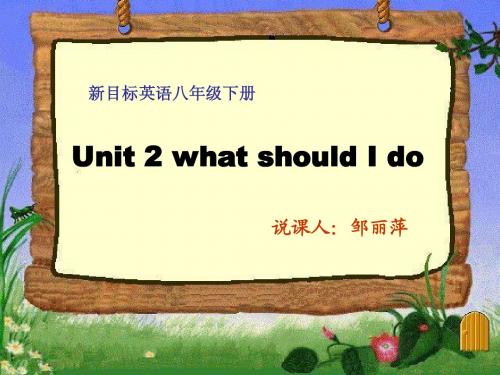
(II) Teaching aims and demands
1. Knowledge Objectives In this lesson, Ss should master the new words ―should/could‖ and the phrase ―pay for,out of style ‖and so on. At the same time, they should know how to use the key structures: --what’s wrong ?/ what’s the matter? 2. Ability Obje—what should I do ? ctives In thisss leon, I’ll mainly train the Students’ listening and speaking abilities and help them develop the Students’ abilities of communication by learning the useful structures. 3. Moral Objectives In this lesson, the Student should learn how to work with others and help each other, how to impress their own ideas during the communication.
Step 5. Group work(9mቤተ መጻሕፍቲ ባይዱnutes)
Read the instructions.Student B gives advice about getting
More money. Student A says if the ideas are good, okay or bad. A: I need some money to buy gifts for my family. What should I do?
英语初二下册Unit 2说课稿
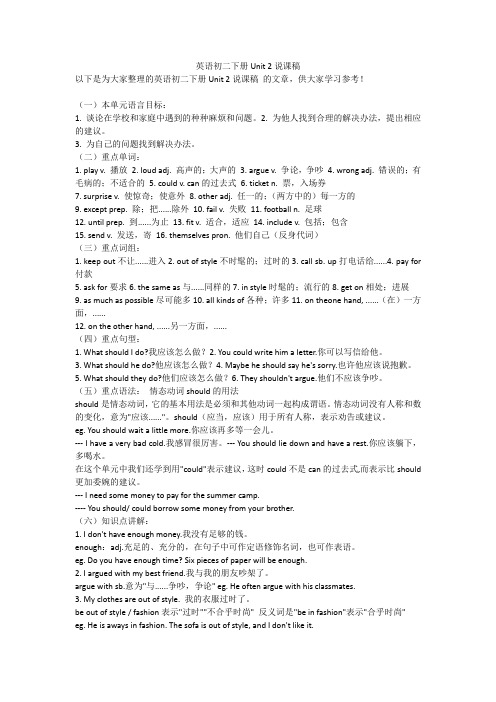
英语初二下册Unit 2说课稿以下是为大家整理的英语初二下册Unit 2说课稿的文章,供大家学习参考!(一)本单元语言目标:1. 谈论在学校和家庭中遇到的种种麻烦和问题。
2. 为他人找到合理的解决办法,提出相应的建议。
3. 为自己的问题找到解决办法。
(二)重点单词:1. play v. 播放2. loud adj. 高声的;大声的3. argue v. 争论,争吵4. wrong adj. 错误的;有毛病的;不适合的5. could v. can的过去式6. ticket n. 票,入场券7. surprise v. 使惊奇;使意外8. other adj. 任一的;(两方中的)每一方的9. except prep. 除;把......除外10. fail v. 失败11. football n. 足球12. until prep. 到......为止13. fit v. 适合,适应14. include v. 包括;包含15. send v. 发送,寄16. themselves pron. 他们自己(反身代词)(三)重点词组:1. keep out不让......进入2. out of style不时髦的;过时的3. call sb. up打电话给......4. pay for 付款5. ask for要求6. the same as与......同样的7. in style时髦的;流行的8. get on相处;进展9. as much as possible尽可能多10. all kinds of各种;许多11. on theone hand, ......(在)一方面,......12. on the other hand, ......另一方面,......(四)重点句型:1. What should I do?我应该怎么做?2. You could write him a letter.你可以写信给他。
【人教版新目标】英语八年级下册Unit2单元教案
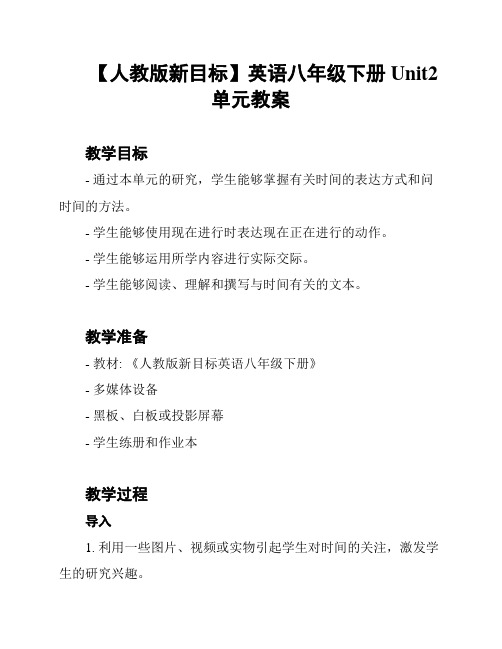
【人教版新目标】英语八年级下册Unit2
单元教案
教学目标
- 通过本单元的研究,学生能够掌握有关时间的表达方式和问时间的方法。
- 学生能够使用现在进行时表达现在正在进行的动作。
- 学生能够运用所学内容进行实际交际。
- 学生能够阅读、理解和撰写与时间有关的文本。
教学准备
- 教材: 《人教版新目标英语八年级下册》
- 多媒体设备
- 黑板、白板或投影屏幕
- 学生练册和作业本
教学过程
导入
1. 利用一些图片、视频或实物引起学生对时间的关注,激发学生的研究兴趣。
规范研究
1. 引导学生研究本单元的词汇和短语,对其进行拼读、理解和运用练。
2. 让学生听录音和跟读对话,掌握现在进行时表达现在正在进行的动作。
拓展研究
1. 带领学生进行交际练,让他们能够用英语问时间和回答时间的问题。
2. 分组进行对话练,加强学生的口语表达能力。
提升研究
1. 给学生分发阅读材料,让他们阅读并回答相关问题,加深对时间概念的理解。
2. 引导学生进行写作练,让他们写一篇短文描述自己一天的日常活动。
教学评估
- 通过学生的课堂表现和活动练,以及书面作业的完成情况来评估学生的掌握程度和进步情况。
教学延伸
- 建议学生在课后进行相关的阅读和听力练,加强对时间的理解和运用能力。
参考资源
- 《人教版新目标英语八年级下册教材》
- 互联网资源(如图片、视频、文章等)。
初二英语第二单元说课稿
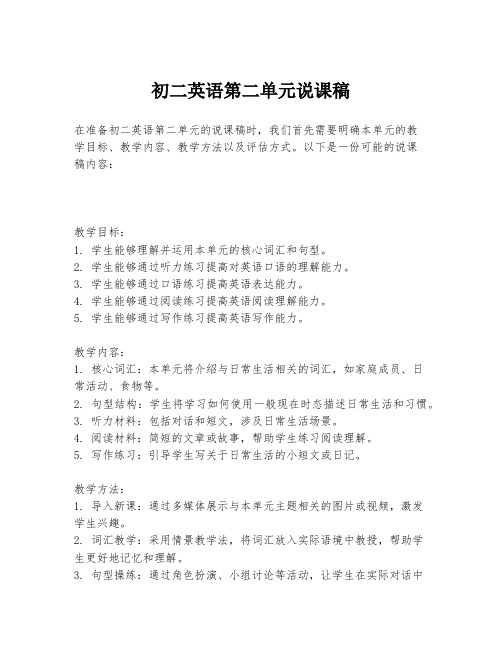
初二英语第二单元说课稿在准备初二英语第二单元的说课稿时,我们首先需要明确本单元的教学目标、教学内容、教学方法以及评估方式。
以下是一份可能的说课稿内容:教学目标:1. 学生能够理解并运用本单元的核心词汇和句型。
2. 学生能够通过听力练习提高对英语口语的理解能力。
3. 学生能够通过口语练习提高英语表达能力。
4. 学生能够通过阅读练习提高英语阅读理解能力。
5. 学生能够通过写作练习提高英语写作能力。
教学内容:1. 核心词汇:本单元将介绍与日常生活相关的词汇,如家庭成员、日常活动、食物等。
2. 句型结构:学生将学习如何使用一般现在时态描述日常生活和习惯。
3. 听力材料:包括对话和短文,涉及日常生活场景。
4. 阅读材料:简短的文章或故事,帮助学生练习阅读理解。
5. 写作练习:引导学生写关于日常生活的小短文或日记。
教学方法:1. 导入新课:通过多媒体展示与本单元主题相关的图片或视频,激发学生兴趣。
2. 词汇教学:采用情景教学法,将词汇放入实际语境中教授,帮助学生更好地记忆和理解。
3. 句型操练:通过角色扮演、小组讨论等活动,让学生在实际对话中练习句型。
4. 听力训练:播放听力材料,让学生完成填空、选择等练习,提高听力理解能力。
5. 阅读理解:指导学生通过略读、寻读等技巧,快速获取文章主旨和细节信息。
6. 写作指导:教授学生如何组织文章结构,使用恰当的连接词,使文章连贯。
评估方式:1. 课堂参与度:观察学生在课堂讨论和活动中的参与情况。
2. 听力测验:定期进行听力测试,评估学生的理解能力。
3. 口语表达:通过角色扮演、演讲等活动,评估学生的口语能力。
4. 阅读理解:通过阅读理解题,评估学生对文章的理解程度。
5. 写作能力:通过作文或日记,评估学生的写作技巧和语言运用能力。
教学资源:1. 教科书:作为主要教学材料,提供词汇、句型和练习。
2. 多媒体资料:图片、视频等,用于激发兴趣和辅助教学。
3. 听力材料:录音或视频,用于听力训练。
新目标八年级英语下册第二单元教学设计(人教版英语八年级)
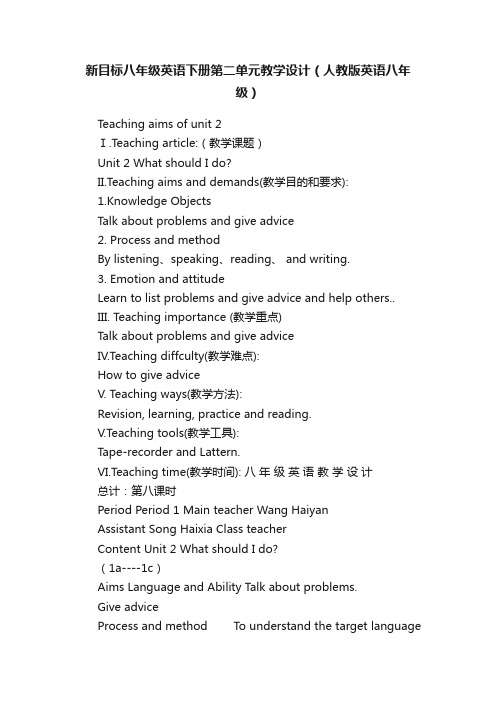
新目标八年级英语下册第二单元教学设计(人教版英语八年级)Teaching aims of unit 2Ⅰ.Teaching article:(教学课题)Unit 2 What should I do?II.Teaching aims and demands(教学目的和要求):1.Knowledge ObjectsTalk about problems and give advice2. Process and methodBy listening、speaking、reading、 and writing.3. Emotion and attitudeLearn to list problems and give advice and help others.. III. Teaching importance (教学重点)Talk about problems and give adviceIV.Teaching diffculty(教学难点):How to give adviceV. Teaching ways(教学方法):Revision, learning, practice and reading.V.Teaching tools(教学工具):Tape-recorder and Lattern.VI.Teaching time(教学时间): 八年级英语教学设计总计:第八课时Period Period 1 Main teacher Wang HaiyanAssistant Song Haixia Class teacherContent Unit 2 What should I do?(1a----1c)Aims Language and Ability Talk about problems.Give adviceProcess and method T o understand the target languageby listening、reading.Emotion and attitude Training the student’s hobbies of studyingImportantPoints Talk about problems.Give adviceDifficult Points could / should, how to give adviceMethods 1.Reading method.2.Speaking method.3.Self check method.Aids 1.A projector.rge chart paper, colored markers. Revision and perfectionproceduresproceduresStep 1 Leading in1.Greetings .2.Free talk.Step 2 Pre-taskTeach the new words and phrases.Step 3 While-taskSB Page10,1a & 1b.Point to the advice and ask someone to read the each one to the class .Discuss and finish the box in group.3、Play the recording and let Ss fill in the chart .Check the answers .SB Page 10 , 1c .1、Point out the sample conversation in activity 1c .2、Ask two Ss to read it to the class .Have Ss work in pairs .Step4 Pair work:1.Point out the conversation in the box in activity 1c. ask two students to read it to the class.2.Ask the students work with a partner. Make your own conversations about the people in the picture.3.Then ask several pairs to say their conversations to the class..Step 5 SummaryToday we’ve learned the key vocabulary and the target of the unit by reading and writing.Blackboard design Unit 2 What should I do?(1a----1c)Serious ot SeriousWhat’s wrong…?== What’s the matter……?Maybe I should------.A: What’s wrong/the matter?B: My clothes are out of style.A: Maybe you should buy some new clothes.B: But I don’t have enough money.Homework Make a conversation using “What’s wrong…?.Reflection after class八年级英语教学设计总计:第九课时Period Period 2 Main teacher Wang HaiyanAssistant Song Haixia Class teacherContent Unit 2 What should I do?(2a----2c)Aims Language and Ability Talk about problems.Give adviceProcess and method T o understand the target languageby listening、reading.Emotion and attitude Training the student’s hobbies of studyingImportantPoints Talk about problems.Give adviceDifficult Points How to give adviceMethods 1.Reading method.2.Speaking method.3.Self check method.Aids 1.A projector.rge chart paper, colored markers. Revision and perfectionproceduresproceduresStep 1 warm up.Greet the class as usual and check the homework.Step 2 Post-taskSB Page 11 , 2a & 2b .1、First point to the chart in activity 2a and get Ss to know what to do ,then play the re cording and ask Ss to check “yes” or “no” .2、Correct the answers .Do with activity 2b in the same way .Step 3 PairworkSB Page 11 , 2c .Ss work in pairs , then ask some pairs to act out their conversations .Step 4 Summary1.Today we’ve reviewed the key vocabulary and the target of the unit by reading and writing.2.Grammar focus.1)Learn the grammar focus by heart.Get ss to go over grammar focus。
人教新目标八年级英语下册第二单元教案(教学设计)

Teaching Aims Knowledge Objects1.Master new words and main sentences.2.Read and find out some message.3.Finish exercises through reading.Ability Objects1.Be able to master new words and main sentences.2. Be able to improve students’ ability of reading.3. Be able to Improve ability of reading through reading and doing exercises.Emotion attitudes and valuesTeach students to love others and make them do something to help others.Teaching KeyPoints 1.Master new words and main sentences.2.Improve ability of reading through reading and doing exercises.TeachingDifficult PointsFinish exercises through reading.TeachingMethodsReadingLearningMethodsReadingTeachingpreparationRadioTeaching Procedures Teaching Notes Step I Warming up and revisionStep II ReadingFast Reading1. T: Now let’s work on 2b. First, let’s read the questions and make surewe know the meanings of all the questions. Then read the passagequickly and find the answers to the questions.1) What kind of letter is it? 2) Who wrote the letter to Miss Li? Why?2. Ss read the letter quickly and try to find the answers to the twoquestions.3. Check the answers with the class.Careful Reading1. T: Now let’s read these sentences about the letter. Read the passageagain. Judge if the sentences are True or False. Please underline underthe main sentences.1) The writer can’t use her arms or legs w ell.2) Lucky was brought to the writer by her friend.3) They have been trained at “Animal helpers” for seven months.4) A dog-helper is for those who are disabled.5) Lucky can understand different orders.Language points1) I’m sure you know that this group was set up to help disabled peoplelike me. set up e.g. Let’s set up our tent by the river.2) Lucky makes a big difference to my life.make a diff erence e.g. It would make a big difference to my life.3) I love animals and I was excited about the idea of having a dog.excited adj. 激动的;兴奋的4) …but many people have these difficulties.difficulty n. 困难;难题difficult adj. 困难的difficulty n.e.g. When you’re in difficulty, ask me for difficulty.Work on 2c1. Let some Ss circle the part of speech.2. Ss try to make sentences with the words.3. Let some Ss read their sentences and correct their mistakes.4. Ss check the sentences with their partners.Work on 2d1.Ss work by themselves.2. Check the answers together.Step III Discussing1. Ss talk about with partners.2. Ask some Ss say what their answers.Step IV Homework :1. Learn some words by heart.2. Finish off some WB. Exercises.3. Try to retell the letter.Reflection afterteaching单元(章) 名称、课题Unit 2 I’ll help to clean up the city parks.Section B 2 (3a-Self check)课时划分8课时教学课时第8课时总备课数第16课时。
八下u2英语说课稿
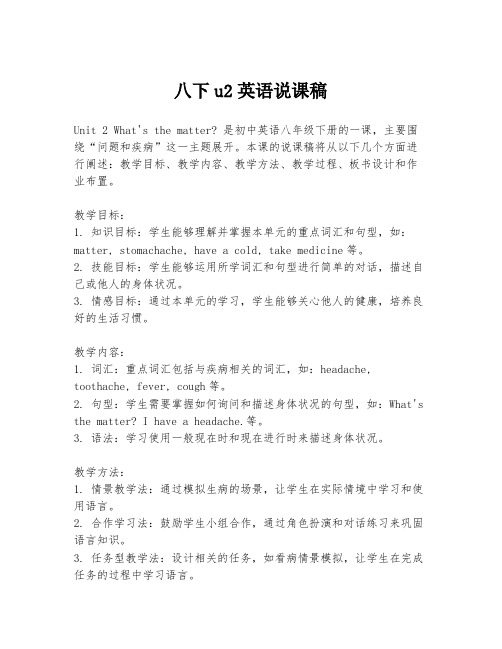
八下u2英语说课稿Unit 2 What's the matter? 是初中英语八年级下册的一课,主要围绕“问题和疾病”这一主题展开。
本课的说课稿将从以下几个方面进行阐述:教学目标、教学内容、教学方法、教学过程、板书设计和作业布置。
教学目标:1. 知识目标:学生能够理解并掌握本单元的重点词汇和句型,如:matter, stomachache, have a cold, take medicine等。
2. 技能目标:学生能够运用所学词汇和句型进行简单的对话,描述自己或他人的身体状况。
3. 情感目标:通过本单元的学习,学生能够关心他人的健康,培养良好的生活习惯。
教学内容:1. 词汇:重点词汇包括与疾病相关的词汇,如:headache, toothache, fever, cough等。
2. 句型:学生需要掌握如何询问和描述身体状况的句型,如:What's the matter? I have a headache.等。
3. 语法:学习使用一般现在时和现在进行时来描述身体状况。
教学方法:1. 情景教学法:通过模拟生病的场景,让学生在实际情境中学习和使用语言。
2. 合作学习法:鼓励学生小组合作,通过角色扮演和对话练习来巩固语言知识。
3. 任务型教学法:设计相关的任务,如看病情景模拟,让学生在完成任务的过程中学习语言。
教学过程:1. 导入(Lead-in):通过展示一些生病的图片,激发学生对本单元主题的兴趣。
2. 新课呈现(Presentation):教授新词汇和句型,并通过多媒体教学工具辅助学生理解。
3. 练习(Practice):通过小组对话、角色扮演等形式,让学生在实际情境中练习使用新词汇和句型。
4. 应用(Application):设计一些实际应用任务,如写一篇关于自己生病经历的短文。
5. 总结(Summary):回顾本节课的重点内容,确保学生能够掌握。
板书设计:- Unit 2 What's the matter?- Key Vocabulary: headache, toothache, fever, cough, stomachache...- Sentence Structures: What's the matter? I have a headache. You should see a doctor.作业布置:1. 完成课后练习题,巩固本课所学词汇和句型。
英语人教版八年级下册UNIT2 说课稿

八年级英语下册第二单元说课稿Unit 2 I’ll help to clean up the city parks一、教学理念《英语课程标准》(实验稿)明确提出了基础教育阶段的总体教学目标是“以学生语言技能、语言知识、情感态度、学习策略和文化意识的发展为基础,培养学生综合运用英语语言的能力”。
新教材也处处体现了以学生为主体的教学理念和任务型教学模式。
新的教学理念根据学习的内容,设计各种交际任务活动,让学生在完成活动任务的过程中习得语言,从而激发学生学习英语的兴趣和积极性,培养学生用英语表达思想和交际的能力;同时增强学生参与意识、竞争意识和团队精神,从而为学生创造一个积极而愉悦的学习氛围,使学生真正成为学习的主人,真正做到学在其中,乐在其中,为学生的终身学习打下坚实基础。
二、教材分析1、教材的地位及作用这套教材采用任务型语言教学(Task-based Language Teaching)模式。
教材中每单元都设计一个或几个与该单元话题有关的任务,让学生在完成任务的过程中,使用英语获取信息,用英语进行交流,培养运用英语解决实际问题的能力。
本单元是初中英语新教材八年级第二单元,本单元的核心话题为“volunteering”,围绕着主动提供帮助,以观察图片、听力理解、阅读理解等训练方式和独立学习、合作交流、完成任务等形式完成目标语言的输入,学习“I will …”,“I would like…I hope…”等句型和一些重要动词短语为主要学习内容,并且设置任务型综合性语言实践活动,让学生在交际活动中,学会如何正确地用英语表达自己的意见和建议,重在培养学生的习得语言运用能力、实践能力、合作能力及创新意识。
2、教学目标(1)知识与能力1)重点词汇:●clean up, set up, take after, fix up, cheer up, put off, hand out, call up, give away, run out of, give out, hunger, sign, repair重点句型:● I’d like to work outside.● I’d help to clean up the city park.● You could give out food at a food bank.2)依托本单元的语言素材提高学生听、说、读、写及自学、创新和沟通能力。
八下英语第二单元说课稿
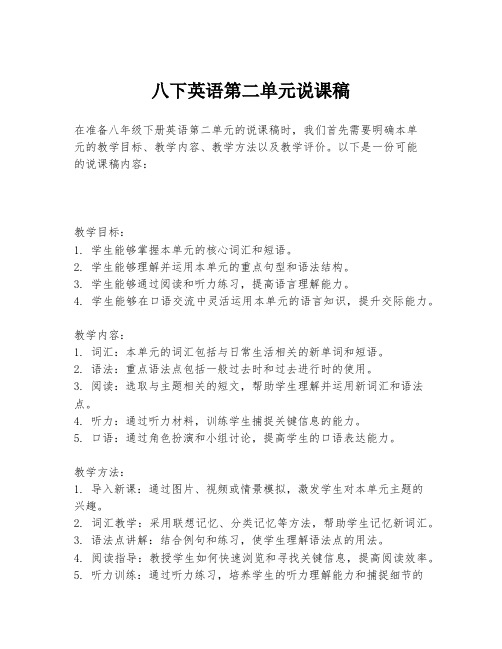
八下英语第二单元说课稿在准备八年级下册英语第二单元的说课稿时,我们首先需要明确本单元的教学目标、教学内容、教学方法以及教学评价。
以下是一份可能的说课稿内容:教学目标:1. 学生能够掌握本单元的核心词汇和短语。
2. 学生能够理解并运用本单元的重点句型和语法结构。
3. 学生能够通过阅读和听力练习,提高语言理解能力。
4. 学生能够在口语交流中灵活运用本单元的语言知识,提升交际能力。
教学内容:1. 词汇:本单元的词汇包括与日常生活相关的新单词和短语。
2. 语法:重点语法点包括一般过去时和过去进行时的使用。
3. 阅读:选取与主题相关的短文,帮助学生理解并运用新词汇和语法点。
4. 听力:通过听力材料,训练学生捕捉关键信息的能力。
5. 口语:通过角色扮演和小组讨论,提高学生的口语表达能力。
教学方法:1. 导入新课:通过图片、视频或情景模拟,激发学生对本单元主题的兴趣。
2. 词汇教学:采用联想记忆、分类记忆等方法,帮助学生记忆新词汇。
3. 语法点讲解:结合例句和练习,使学生理解语法点的用法。
4. 阅读指导:教授学生如何快速浏览和寻找关键信息,提高阅读效率。
5. 听力训练:通过听力练习,培养学生的听力理解能力和捕捉细节的能力。
6. 口语实践:通过小组讨论、角色扮演等活动,鼓励学生开口说英语。
教学评价:1. 课堂表现:观察学生在课堂上的参与度和互动情况。
2. 作业检查:定期检查学生的作业,了解学生对知识点的掌握情况。
3. 口语测试:通过口语测试,评估学生的口语表达能力和语言运用能力。
4. 单元测试:通过单元测试,检验学生对本单元知识的综合运用能力。
教学反思:在教学过程中,教师应不断反思教学方法的有效性,及时调整教学策略,以适应不同学生的学习需求。
同时,教师应鼓励学生提出问题和建议,共同促进教学效果的提升。
请注意,这只是一个示例说课稿,具体的教学内容和方法应根据实际教学情况和学生的具体情况进行调整。
- 1、下载文档前请自行甄别文档内容的完整性,平台不提供额外的编辑、内容补充、找答案等附加服务。
- 2、"仅部分预览"的文档,不可在线预览部分如存在完整性等问题,可反馈申请退款(可完整预览的文档不适用该条件!)。
- 3、如文档侵犯您的权益,请联系客服反馈,我们会尽快为您处理(人工客服工作时间:9:00-18:30)。
八年级英语下册第二单元说课稿
Unit 2 I’ll help to clean up the city parks
(section A 1a-1c) 第一课时
一、教学理念
《英语课程标准》(实验稿)明确提出了基础教育阶段的总体教学目标是“以学生语言技能、语言知识、情感态度、学习策略和文化意识的发展为基础,培养学生综合运用英语语言的能力”。
新教材也处处体现了以学生为主体的教学理念和任务型教学模式。
新的教学理念根据学习的内容,设计各种交际任务活动,让学生在完成活动任务的过程中习得语言,从而激发学生学习英语的兴趣和积极性,培养学生用英语表达思想和交际的能力;同时增强学生参与意识、竞争意识和团队精神,从而为学生创造一个积极而愉悦的学习氛围,使学生真正成为学习的主人,真正做到学在其中,乐在其中,为学生的终身学习打下坚实基础。
二、教材分析
1、教材的地位及作用
这套教材采用任务型语言教学(Task-based Language Teaching)模式。
教材中每单元都设计一个或几个与该单元话题有关的任务,让学生在完成任务的过程中,使用英语获取信息,用英语进行交流,培养运用英语解决实际问题的能力。
本单元是初中英语新教材八年级第二单元,本单元的核心话题为“volunteering”,围绕着主动提供帮助,以观察图片、听力理解、阅读理解等训练方式和独立学习、合作交流、完成任务等形式完成目标语言的输入,学习“I will ...”,“I would like (I)
hope…”等句型和一些重要动词短语为主要学习内容,并且设置任务型综合性语言实践活动,让学生在交际活动中,学会如何正确地用英语表达自己的意见和建议,重在培养学生的习得语言运用能力、实践能力、合作能力及创新意识。
2、教学目标
(1)知识与能力
1)重点词汇:●clean up, set up, take after, fix up, cheer up, put off, hand out, call up, give away, run out of, give out, hunger, sign, repair
重点句型:● I’d like to work outside.
● I’d help to clean up the city park.
● You could give out food at a food bank.
2)依托本单元的语言素材提高学生听、说、读、写及自学、创新和沟通能力。
熟练掌握“I will …”,“I would like…I hope…”等句型,培养学生运用语言的能力。
3)培养学生善于听说、乐于听说的良好习惯和学习能力。
4)在表演和讨论中培养学生乐于表达的人际交往能力和知识创新能力。
(2)过程与方法
1)通过短文阅读,进一步提高学生阅读能力;
2)通过复述吉米的故事,提高学生的口语表达能力;
3)通过采访及小组合作等方式,进一步提高学生的语言综合运用能力。
(3)情感态度及价值观
1)深刻理解志愿者工作是伟大的;
2)帮助他人让你我他更开心,让世界更美好;
3)志愿者工作是一种社会文化,是世界范围的热点话题。
3. Pair work
重点:“I will …”,“I would like…I could help to…”句型及部分重要动词短语。
难点:做什么样的志愿者工作及如何去做?
确立重点与难点的依据:根据教学大纲的要求,及本单元在教材中所处的地位和作用。
三、学情分析
学情剖析:八年级学生正处于感性向理性的转型期,求知欲和表现参与意识很强,有一定的逻辑分析能力,同时也需要教师的积极引导。
本单元的主题是开展有关志愿者活动,是学生很感兴趣的话题。
学生可以采用Teamwork和Role playing的学习策略,学习新词汇,掌握重点句型和主要内容,同时能比较好地解决类似问题(志愿者活动、制定活动计划),既能运用所学知识,联系实际生活,又能提高解决问题以及综合运用语言能力。
四、教法、学法设计
为达成上述教学目标,根据Go for it!教材的特点,我们将运用任务型教学途径,而学生也相应地采取自主、合作、探究的学习方式。
本单元采用Teamwork、Interview、Telling stories、Discussion和Role playing的学习策略,掌握重要短语和句型,提高听说读的能力。
1.教法设计
教学内容的核心要求符合科学规律、认识规律,因此我在教学过程中,正确把握教育教学的特点,倡导预习检测、合作探究、当堂检测,课后作业的学习方式,激发兴趣,调动思维,培养创新能力。
通过层层任务导入,精讲巧练,由浅入深,由易到难,由已知到未知,循序渐进地深化教学内容。
展开以教师为主导,以学生为主体的师生双边活动。
采用视听法、角色扮演、情景交际法和小组互助型学习法,并把竞争机制引入课堂。
(1)视听法,主要通过老师提问、学生回答等方式提供让学生听、说的练习机会;
(2)情景交际法,让学生利用多媒体课件上展示的句型,听力材料和课文内容进行交流,教师和学生进行情景对话的方式在实践中获得信息,习得英语。
(3)小组互助型学习法,小组合作解决志愿者活动中做什么、如何去做等问题。
对教材的处理上本着,以“旧”启“新”,以“练”促“学”,以“熟”生“巧”的原则,通过听说、朗读、对话、和小组表演,提高口语表达能力,且英语口语表演能够活跃课堂气氛,使学生愉快学习,真正做学习的主人。
2.学法设计
本单元主要的任务就是要让学生学会运用习得语言知识结合自己谈论有关志愿者活动,在任务型活动中学习并巩固本单元的内容。
因此在教学中,教师主要是让学生学会:
1)课前预习,尝试自学;
2)培养学生大胆发言、积极思维、合作能力;
3)课堂认真听讲,养成好习惯,提高学习效率;
4)复习巩固,拓展新知。
五、教学过程
(一)预习检测
教师创设情景,预习第一单元主要学习的内容,例如,通过教师说身体不适让学
生回忆第一单元学习的给出建议的相关句型。
(二)导入
1.由于本课主题是帮助他人,所以通过歌曲《学习雷锋好榜样》来导入新课,让学生对本课的主题个初步理解。
导出新单词,如,clean up, set up, take after, fix up, cheer up, put off, hand out等。
(三)新课交际和训练阶段
1.利用多媒体课件,展示一些图片,并给出句型模式,让学生们一起来编造句子,最后以小组形式进行情景对话,这样有助于学生提高口语交际能力并且通过互动更容易掌握本课的重要语法点。
2.听录音,根据听力内容完成课后习题,并且在二次放录音时要求学生能够根据课后习题,能够听写四则短对话的内容,并复述所听到的内容。
(四)总结拓展
反复运用本节重点句型练习本节重点短语句型,引导学生总结本节重难点知识。
并让学生在学习和运用中,学会英语。
(五)完成学案并进行讲解。
(六)课后作业。
六、板书
Unit 2 I’ll help to clean up the city parks.
Phrasal verbs:
put off, hand out, call up, give away,
run out of, clean up, set up, take after,
fix up, cheer up, give out, sign, repair
Offer help: I’d like to …
I will …
I want to …
You could …。
